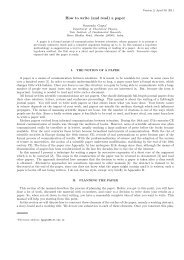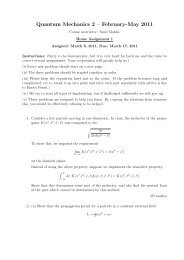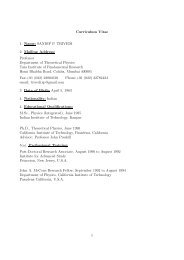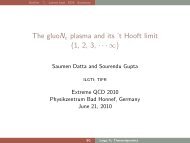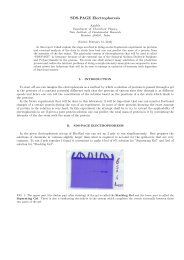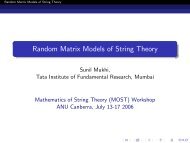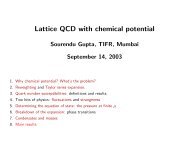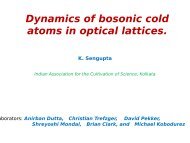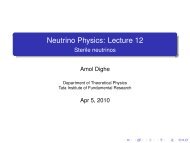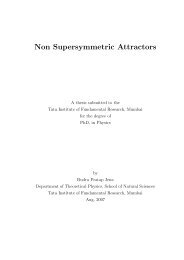Hot Stuff - Department of Theoretical Physics - Tata Institute of ...
Hot Stuff - Department of Theoretical Physics - Tata Institute of ...
Hot Stuff - Department of Theoretical Physics - Tata Institute of ...
You also want an ePaper? Increase the reach of your titles
YUMPU automatically turns print PDFs into web optimized ePapers that Google loves.
PHYSICS NEWS<br />
<strong>Hot</strong> <strong>Stuff</strong><br />
Sourendu Gupta<br />
<strong>Department</strong> <strong>of</strong> <strong>Theoretical</strong> <strong>Physics</strong><br />
<strong>Tata</strong> <strong>Institute</strong> <strong>of</strong> Fundamental Research<br />
Homi Bhabha Road, Mumbai 400005, India October 31, 2012<br />
“The author works on hot matter, a topic which lies at the intersection <strong>of</strong><br />
particle physics, computer algorithms and quantum field theory. He studied<br />
at IIT Kharagpur and TIFR, and has worked in IMSC Chennai, CERN, and<br />
Brookhaven National Laboratory. He is also interested in the teaching <strong>of</strong><br />
physics. His web page address is http://theory.tifr.res.in/~sgupta/”<br />
“Photograph courtesy <strong>of</strong> Radiya Pacha<br />
Gupta. Reproduced with permission.”<br />
Abstract : <strong>Hot</strong> strongly interacting matter once filled the universe, but in the last 14 billion years it<br />
has only been briefly produced in relativistic collisions <strong>of</strong> heavy ions. Its properties can be extracted<br />
from a quantum field theory using supercomputers. Now a collaboration <strong>of</strong> experiments and theory is<br />
beginning to test this connection accurately, I describe what has been found, the context, and what we<br />
hope to gain in the next few years.<br />
1 Why study hot matter?<br />
To the best <strong>of</strong> our knowledge, the<br />
universe started with a hot big bang.<br />
Through its entire history, the<br />
universe has been cooling while<br />
remaining very nearly in thermal<br />
equilibrium (our experience <strong>of</strong> the<br />
universe is atypical, since most <strong>of</strong> it<br />
is now at 3 K). We have very detailed<br />
knowledge <strong>of</strong> the physics that<br />
involves the evolution <strong>of</strong> the universe<br />
when it was older than a couple<br />
<strong>of</strong> microseconds. Understanding<br />
the earlier history <strong>of</strong> the universe<br />
involves the kind <strong>of</strong> physics that is<br />
the subject <strong>of</strong> this article: relativistic<br />
quantum field theories at very high<br />
temperatures.<br />
This era <strong>of</strong> the universe involves<br />
temperatures in excess <strong>of</strong> 10 9 K (1<br />
trillion K), so the need to study<br />
extremely hot matter is clear. But<br />
why do we need relativity and<br />
quantum field theory?<br />
The reasons are very simple. The<br />
kinetic energy <strong>of</strong> a particle in thermal<br />
equilibrium is <strong>of</strong> the order <strong>of</strong> the<br />
temperature 1 T. When two particles<br />
in such a system collide, their center<br />
<strong>of</strong> mass energy is also <strong>of</strong> order T.<br />
Now, if the masses <strong>of</strong> the particles,<br />
M, are much smaller than T, then<br />
the Lorentz factor, γ = T/M, is much<br />
larger than unity, and the particles<br />
are relativistic. Furthermore, in<br />
these circumstances, particles can be<br />
produced in every inelastic collision.<br />
We know from decades <strong>of</strong><br />
experiments that quantum<br />
mechanics works perfectly well for a<br />
system <strong>of</strong> fixed number <strong>of</strong> particles.<br />
So, for example, quantum mechanics<br />
is all that is needed to understand<br />
the spectra <strong>of</strong> atoms and nuclei,<br />
transport in nanowires, information<br />
processing through the use <strong>of</strong><br />
entangled states, and many more<br />
mundane or exotic fields <strong>of</strong> research.<br />
However, this quantum mechanics<br />
is inadequate when particles are<br />
produced. Even to adequately<br />
understand the simple reaction H H<br />
H* H + γ i.e., the decay <strong>of</strong> an<br />
excited hydrogen atom to its ground<br />
state with the production <strong>of</strong> a<br />
photon, one has to use quantum field<br />
theory. So, to explain the physics <strong>of</strong> a<br />
thermal medium which consists <strong>of</strong><br />
relativistic particles, one has to use<br />
quantum field theory.<br />
2 What kind <strong>of</strong> matter?<br />
But which quantum field theory<br />
should one use for the description<br />
<strong>of</strong> matter at the beginning <strong>of</strong> the<br />
universe? Fortunately, over the last<br />
hundred years experiments have<br />
narrowed the field until only one<br />
theory seems to be adequate for<br />
the description <strong>of</strong> the universe a<br />
nanosecond or more after its birth.<br />
The story started with the discovery<br />
<strong>of</strong> the atomic nucleus by Rutherford<br />
in 1911. Since the nucleus is<br />
positively charged (consisting <strong>of</strong><br />
positively charged protons and<br />
neutral neutrons) it was already<br />
clear that electromagnetic forces<br />
would tear it apart, and a new force<br />
1<br />
Throughout this article I will use units such that the Boltzmann constant, k, is unity. Since we will have to use relativity, I will<br />
choose units such that the speed <strong>of</strong> light in vacuum, c, is also unity. Finally, since much <strong>of</strong> the relevant physics is quantum, I will<br />
choose units such that ħ, Planck’s constant, is unity.<br />
1
PHYSICS NEWS<br />
was required to bind the nucleus<br />
into a stable entity. This was called<br />
the strong force.<br />
A detailed understanding <strong>of</strong> the<br />
spectrum <strong>of</strong> hydrogen showed that<br />
the electron and the proton interacted<br />
only by the electromagnetic forces.<br />
So clearly all matter in the universe<br />
was divided into kinds which saw<br />
the strong forces (these are called<br />
hadrons) and others which did not<br />
(these are called leptons). Half a<br />
century <strong>of</strong> discoveries which followed<br />
only deepened the mystery. So many<br />
more hadrons were observed that it<br />
became more and more unlikely that<br />
they are all elementary constituents<br />
<strong>of</strong> matter. At the same time all<br />
attempts at creating a theoretical<br />
model <strong>of</strong> these particles, considered<br />
as elementary, failed. In 1961 the<br />
first breakthrough came with the<br />
invention <strong>of</strong> the “quark model” by<br />
Gell-Mann [1]. This hypothesized<br />
that the elementary constituents <strong>of</strong><br />
strongly interacting matter were new<br />
entities called quarks. In terms <strong>of</strong><br />
these quarks it was possible to build<br />
something like a periodic table <strong>of</strong><br />
hadrons. The model predicted new<br />
hadrons, and was vindicated when<br />
they were found.<br />
Within a decade a relativistic quantum<br />
field theory <strong>of</strong> strong interactions had<br />
been written and technical difficulties<br />
involved in working with it largely<br />
solved. In doing this it was discovered<br />
that this theory, which was called<br />
Quantum Chromo-Dynamics (QCD),<br />
had an intrinsic length scale (which<br />
is about a femto meter). Strangely,<br />
the theory predicted that at distances<br />
much shorter than this scale, the<br />
strong interactions were rather weak<br />
[2]. Experiments soon verified the<br />
quantitative theory <strong>of</strong> the paradoxically<br />
weak strong interactions. The physics<br />
<strong>of</strong> long distances, where the strong<br />
inter- actions are strong required a<br />
reformulation <strong>of</strong> quantum field theory.<br />
Even after this radical invention it<br />
turned out that supercomputers were<br />
needed to make predictions. Since this<br />
forms the core <strong>of</strong> the method used in<br />
the description <strong>of</strong> the hot stuff at the<br />
beginning <strong>of</strong> time, we will return to<br />
this later.<br />
The strong interactions turn out to<br />
be the hardest theoretical and experimental<br />
challenge in physics until<br />
now. They are understood adequately<br />
enough for people to work with, but<br />
not enough to be considered solved<br />
and done with. At the end <strong>of</strong> a century<br />
about 30 Nobel prizes, to more than<br />
50 people, have been awarded for the<br />
strong interactions alone; the most<br />
recent was in 2010. This makes it the<br />
most awarded field in physics — a<br />
good indication <strong>of</strong> the continuing<br />
interest in the subject. Today it stands<br />
as the hardest part <strong>of</strong> the Standard<br />
Model <strong>of</strong> particle physics: a theory<br />
now verified through the recent<br />
discovery <strong>of</strong> the Higgs boson in the<br />
Large Hadron Collider (LHC) in<br />
CERN, and ready for application to<br />
the problem <strong>of</strong> the early evolution <strong>of</strong><br />
the universe.<br />
In order to have any confidence in our<br />
ability to do this, one has to design<br />
experiments to test the predictions<br />
<strong>of</strong> quantum field theory at high<br />
temperature. This is where the strong<br />
interactions come in. It turns out that<br />
the easiest way to produce hot matter<br />
is to bang heavy nuclei together in<br />
a high energy collider. The kinetic<br />
energy is converted to the thermal<br />
energy <strong>of</strong> a fireball which expands and<br />
cools, roughly in the same way that the<br />
universe did. These little bangs are full<br />
<strong>of</strong> strongly interacting matter.<br />
As a result, although QCD is the<br />
hardest part <strong>of</strong> the Standard Model,<br />
it turns out to be the most relevant at<br />
the present stage <strong>of</strong> testing our notions<br />
about the universe in its infancy.<br />
3 Supercomputing in<br />
quantum field theory<br />
When interactions are weak, the<br />
usual method <strong>of</strong> computation in any<br />
quantum theory is by developing<br />
a perturbation series. This works<br />
beautifully in the quantum theory <strong>of</strong><br />
electrodynamics, making it the most<br />
precisely tested physical theory <strong>of</strong> all<br />
times. However, this method is not<br />
available to us for strong interactions.<br />
Instead we rely on a reformulation<br />
which rests on two legs — the path<br />
integral method <strong>of</strong> Feynman and the<br />
grand synthesis <strong>of</strong> Wilson.<br />
The origin <strong>of</strong> quantum mechanics<br />
and wave-particle duality is seen in<br />
the two-slit interference experiment.<br />
A quantum particle, such as an<br />
electron, is described by a probability<br />
amplitude. When an electron<br />
impinges on a screen with two<br />
slits then it goes through both; the<br />
amplitudes <strong>of</strong> it taking either path<br />
have to be added. A detector placed on<br />
the other side <strong>of</strong> the screen can detect<br />
the electron at some position with a<br />
probability proportional to the square<br />
<strong>of</strong> the summed amplitude. This gives<br />
rise to the usual interference patterns.<br />
If a stream <strong>of</strong> electrons is sent through<br />
the apparatus then the detector<br />
sees more electrons in the regions<br />
where the interference maxima are,<br />
and less where there is destructive<br />
interference. This much was known<br />
from the 1920s. Feynman’s insight in<br />
the 1940s was that the number <strong>of</strong> slits<br />
could be increased indefinitely, and<br />
all the different paths that the particle<br />
could take would still interfere. In<br />
fact, the screen could be removed<br />
altogether and the resultant infinity <strong>of</strong><br />
paths would still interfere. Therefore<br />
the amplitude <strong>of</strong> a quantum particle<br />
to travel from the position x i<br />
at time<br />
t i<br />
to a position x f<br />
at time t f<br />
would be<br />
the sum (integral) <strong>of</strong> the amplitudes<br />
for all possible paths [3].<br />
An interesting duality was noticed in<br />
quantum mechanics since its beginning.<br />
Time evolution in quantum<br />
mechanics involves the unitary<br />
operator exp (iHt) where H is the<br />
Hamiltonian operator <strong>of</strong> the system<br />
and t is the time. At the same time,<br />
M[MeV]<br />
2000<br />
1500<br />
1000<br />
500<br />
0<br />
p<br />
K<br />
r K*<br />
S X<br />
L<br />
N<br />
Figure 1: A comparison <strong>of</strong> experimentally<br />
determined masses <strong>of</strong> hadrons<br />
with those predicted by QCD. Three<br />
parameters <strong>of</strong> the theory are adjusted<br />
by input <strong>of</strong> the masses <strong>of</strong> the π, K and Σ.<br />
The remainder are predictions [5].<br />
D<br />
O<br />
X*<br />
S*<br />
experiment<br />
width<br />
input<br />
QCD<br />
2
PHYSICS NEWS<br />
the statistical mechanics <strong>of</strong> the same<br />
quantum system involves a density<br />
matrix exp (−H/T) where T is the<br />
temperature. The two are related by<br />
the identification t i/T, and their<br />
path integral representations are also<br />
similarly related. Exploiting this,<br />
Wilson was able to convert all the<br />
technical problems <strong>of</strong> quantum field<br />
theory into the statistical mechanics<br />
<strong>of</strong> particles on a space-time lattice,<br />
while being able to control the<br />
limit in which the lattice spacing<br />
goes to zero [4]. This is the grand<br />
synthesis <strong>of</strong> modern theoretical<br />
physics, as a result <strong>of</strong> which<br />
amplitudes in quantum field theory<br />
can be computed by a numerical<br />
evaluation <strong>of</strong> the corresponding<br />
statistical mechanics. In the 1970s<br />
when Wilson created the grand<br />
synthesis, numerical methods for<br />
statistical mechanics had already<br />
been evolving for a decade or so,<br />
and could be turned to the lattice<br />
formulation <strong>of</strong> QCD and other<br />
quantum field theories immediately.<br />
Such a treatment <strong>of</strong> quantum field<br />
theory turns out to require incredibly<br />
large computing power. The biggest<br />
supercomputers available today,<br />
IBM’s Blue Gene series, was first<br />
designed by field theorists to solve<br />
the problem <strong>of</strong> QCD, and has now<br />
been turned to other uses such as<br />
hydrodynamics, drug design, code<br />
breaking and weather prediction,<br />
and much more. The result is that<br />
some predictions <strong>of</strong> QCD are now<br />
marvelously precise. Two years ago<br />
there was a superb calculation <strong>of</strong> the<br />
masses <strong>of</strong> all hadrons up to twice the<br />
mass <strong>of</strong> the proton, in which QCD<br />
was seen to work beautifully (see<br />
Figure 1).<br />
4 A technical problem and its<br />
solution<br />
A decade ago several Indian<br />
physicists with interest in lattice<br />
QCD got together to form the Indian<br />
Lattice Gauge Theory Initiative<br />
(ILGTI). The aim <strong>of</strong> this initiative was<br />
to set up the kind <strong>of</strong> supercomputing<br />
facilities which are required for<br />
lattice gauge theory. It was first<br />
supported by the <strong>Department</strong> <strong>of</strong><br />
Atomic Energy, which continues to<br />
lend strong support to this program.<br />
In the Xth five year plan facilities<br />
were set up in TIFR Mumbai, IMSc<br />
Chennai and SINP Kolkata. In the<br />
XIth five year plan the TIFR facility<br />
expanded to become the fifth largest<br />
supercomputing center in the<br />
country. New centers are coming<br />
up in IACS Kolkata and NISER<br />
Bhubaneshwar 2 There are enormous<br />
opportunities here for anyone who<br />
wishes to be part <strong>of</strong> the initiative,<br />
as explained in the web page http://<br />
www.ilgti.tifr.res.in.<br />
With these facilities available, Indian<br />
collaborations began to look at hard<br />
unsolved problems. One problem<br />
that was examined by my colleagues<br />
and I in the group in TIFR Mumbai<br />
was a long-standing puzzle called<br />
the “sign problem” which arose in<br />
many areas <strong>of</strong> computational science.<br />
In the context <strong>of</strong> quantum field<br />
theory one can state the problem<br />
as the following. When the path<br />
integral <strong>of</strong> quantum field theory is<br />
converted into statistical mechanics,<br />
then it becomes an integral <strong>of</strong> a<br />
function which is defined in an<br />
infinite dimensional space but is<br />
positive. The lattice reduces this<br />
infinity into a very large but finite<br />
number <strong>of</strong> dimensions (typically<br />
larger than 10 6 ).<br />
A method <strong>of</strong> numerical integration<br />
called the Monte Carlo method is<br />
then applied. This works only when<br />
the integrand is positive. However,<br />
in field theory problems when<br />
the number <strong>of</strong> particles and antiparticles<br />
is not exactly equal, the<br />
integrand is not positive definite<br />
but complex, and the method fails.<br />
This failure had stopped lattice<br />
QCD investigations <strong>of</strong> the little<br />
bang, where the number <strong>of</strong> baryons<br />
exceeds the number <strong>of</strong> antibaryons.<br />
The TIFR group found a generic<br />
solution to the sign problem. When<br />
particles and antiparticles are not<br />
equal in number, one can reformulate<br />
this problem in the grand canonical<br />
ensemble <strong>of</strong> statistical mechanics<br />
with a chemical potential μ. At μ =<br />
0 the number <strong>of</strong> particles equals the<br />
number <strong>of</strong> antiparticles, the path<br />
integrand is positive, and the Monte<br />
Carlo method works. We proposed<br />
to set up a Madhava-Maclaurin<br />
expansion 3 <strong>of</strong> the free energy at μ =<br />
0. The series coefficients need to be<br />
computed only for μ = 0, and hence<br />
the Monte Carlo methods suffices.<br />
The series is a good tool as long<br />
as it converges, and when it fails<br />
to converge the singularity could<br />
well be related to the interesting<br />
phenomenon <strong>of</strong> a phase transition in<br />
the system [6].<br />
This method was first written down<br />
by us in 2002 and applied to a simple<br />
model system. The first application<br />
to QCD was published in 2005,<br />
and we have updated the results<br />
subsequently in 2008 and are<br />
again in the process <strong>of</strong> doing so<br />
now. Many years <strong>of</strong> continuous<br />
computation on very large supercomputers<br />
are needed in order to<br />
use this technique. The results allow<br />
us to make quantitative and testable<br />
predictions for hot quark matter seen<br />
in experiments for the first time.<br />
5 Thermodynamic<br />
fluctuations<br />
The number <strong>of</strong> gas molecules in the<br />
room you are sitting in right now is<br />
perhaps around 10 28 . When there are<br />
so many degrees <strong>of</strong> freedom, thermodynamics<br />
is easily applied. As a<br />
result, you can easily measure the<br />
pressure, entropy, and enthalpy <strong>of</strong><br />
the gas. The state <strong>of</strong> your knowledge<br />
2<br />
In order to remain globally competitive we need to install petaflops level computing power in the country dedicated to quantum<br />
field theory. A flops is an unit <strong>of</strong> computing power, corresponding to being able to add two floating point numbers in one second.<br />
Most desktops currently operate in the range <strong>of</strong> gigaflops. Computing at higher speeds is needed in many branches <strong>of</strong> science. This<br />
requires parallelization <strong>of</strong> programs. This is a special skill which need to be taught at the graduate level.<br />
3
PHYSICS NEWS<br />
<strong>of</strong> these quantities is limited only by<br />
the accuracy <strong>of</strong> your instruments.<br />
However, if the sample size was<br />
smaller, say about 10 6 molecules,<br />
then there would be intrinsic<br />
physical limits on the accuracy.<br />
Repeating accurate measurements<br />
would not give the same value,<br />
but would reveal thermodynamic<br />
fluctuations. The study <strong>of</strong> these<br />
fluctuations about a hundred years<br />
ago revealed that new physical<br />
information hides here. For example,<br />
the fluctuations <strong>of</strong> energy <strong>of</strong> such a<br />
sample are Gaussian and the width<br />
is related to the specific heat <strong>of</strong> the<br />
material.<br />
S σ<br />
σ 2<br />
κ<br />
T (MeV)<br />
79 140 160<br />
165 166<br />
µ (MeV)<br />
B<br />
720 420 210 54 20 10<br />
(A)<br />
2 m 1<br />
Exp. Data Lattice QCD<br />
HRG<br />
1.5<br />
1<br />
0.5<br />
0<br />
(B)<br />
2<br />
1<br />
0<br />
-1<br />
m 2<br />
-2<br />
4 5 6 10 20 30 100 200<br />
s NN (GeV)<br />
Figure 2: A comparison <strong>of</strong> the<br />
predictions <strong>of</strong> QCD with experimental<br />
determination <strong>of</strong> the shape <strong>of</strong><br />
the spectrum <strong>of</strong> thermodynamic<br />
fluctuations in the excess <strong>of</strong> baryons<br />
over antibaryons in heavy-ion collisions<br />
[7]. The experimental data comes from<br />
an international collaboration called<br />
STAR working with a collider in the<br />
Brookhaven Laboratory near New York.<br />
The lattice predictions come from the<br />
Mumbai chapter <strong>of</strong> the ILGTI.<br />
This looks like a cumbersome way <strong>of</strong><br />
finding the specific heat, but what if<br />
it were so hard to make the material<br />
that there was no way to produce<br />
enough to do a macroscopic<br />
measurement <strong>of</strong> the specific heat?<br />
Then thermodynamic fluctuations<br />
may be the only way to relate<br />
mesoscopic physics (here <strong>of</strong> around<br />
10 6 molecules) to microscopic physics<br />
(the interactions <strong>of</strong> the molecules<br />
(3) (2)<br />
/χ<br />
T χ<br />
(4) (2)<br />
/χ<br />
χ<br />
2<br />
T<br />
which can be used to compute the<br />
specific heat). Quark matter turns<br />
out to be like this. Quark matter is<br />
produced in the lab in little bangs,<br />
creating fireballs which expand and<br />
cool. We see only the end result <strong>of</strong><br />
these collisions. By looking at the<br />
relative number <strong>of</strong> hadrons which<br />
are produced in these bangs, one can<br />
find the temperature and chemical<br />
potential just before the hadrons<br />
leave the fireball. This method is<br />
analogous to the application <strong>of</strong> the<br />
Saha equations to the Fraunh<strong>of</strong>er<br />
spectra <strong>of</strong> stars to find their surface<br />
temperatures. Knowing T and<br />
μ one should be able to predict<br />
thermodynamic fluctuations in the<br />
fireball.<br />
If this were to be possible then it<br />
must also be true that when one<br />
selects a sample <strong>of</strong> fireballs with<br />
a fixed T and μ the distribution <strong>of</strong><br />
a conserved quantity should be<br />
Gaussian. One such quantity is the<br />
excess <strong>of</strong> baryons over antibaryons.<br />
When this is measured in one<br />
little bang after another, it turns<br />
out to be approximately Gaussian<br />
distributed. The deviations from a<br />
Gaussian are as interesting as the<br />
width <strong>of</strong> the Gaussian. It turns out<br />
that the Madhava-Maclaurin series<br />
coefficients which we compute are<br />
precisely the quantities needed<br />
to predict the shape <strong>of</strong> these<br />
distributions. Our computations<br />
were checked against experimental<br />
data and found to agree very well<br />
(see Figure 2). This was a major<br />
milestone since this was the first<br />
time that lattice QCD predictions<br />
could be compared to experimental<br />
data on hot matter.<br />
6 Implications<br />
Lattice QCD has a very small number<br />
<strong>of</strong> free parameters: the QCD distance<br />
scale at which the strong interactions<br />
become weak, and the quark masses.<br />
Once all the free parameters are<br />
fixed everything else is a prediction.<br />
Typically the free parameters<br />
are fixed by matching them to<br />
experimentally determined hadron<br />
masses, as shown in Figure 1.<br />
In fact, exactly this was done in<br />
the comparison shown in Figure 2.<br />
The values <strong>of</strong> T and μ are required<br />
to make a connection between the<br />
experiment and prediction. For<br />
the experimental data these are<br />
determined as explained earlier.<br />
For the lattice QCD prediction the<br />
lattice computation directly gives the<br />
dimensionless ratio T/T c<br />
, where T c<br />
is<br />
a conventional scale <strong>of</strong> temperature<br />
called the QCD crossover<br />
temperature. At temperatures below<br />
T c<br />
strongly interacting matter has a<br />
simple hadronic description; above<br />
T c<br />
it has a simple description in<br />
terms <strong>of</strong> quarks and gluons. Lattice<br />
computations also have predictions<br />
for T c<br />
/m where m is a hadron mass.<br />
As a result, using computations such<br />
as those shown in Figure 1 one can<br />
fix T and μ for the lattice computation<br />
and make the comparison shown in<br />
Figure 2.<br />
However, one need not perform<br />
this very round-about comparison.<br />
Given the data on fluctuations,<br />
one may as well vary the single<br />
parameter T c<br />
and check whether the<br />
data is well described by the lattice<br />
QCD predictions. This was done in a<br />
unique collaboration <strong>of</strong> theorists and<br />
experimentalists with the result that<br />
an excellent fit to the data is obtained<br />
with T c<br />
= 175 +1 −7 MeV.<br />
In more familiar units, T c<br />
is<br />
about 2 trillion K. This result is a<br />
breakthrough because it is the first<br />
time that such a basic parameter<br />
<strong>of</strong> hot primordial matter has<br />
been obtained from experiments.<br />
Interestingly, this is also the highest<br />
measured temperature ever to come<br />
out <strong>of</strong> a terrestrial experiment. It is<br />
high enough to melt atomic nuclei<br />
into its constituents, the quarks.<br />
Apart from this, it is also an<br />
intellectual breakthrough since it<br />
closes a circle <strong>of</strong> reasoning which<br />
3<br />
Madhava <strong>of</strong> Sangamgrama was a member <strong>of</strong> the 13th century school <strong>of</strong> mathematics in Kerala and is supposed to have developed<br />
the method which was discovered independently several centuries later by Maclaurin. Madhava discovered the method and applied<br />
it to the computation <strong>of</strong> the tangent <strong>of</strong> any angle.<br />
4
PHYSICS NEWS<br />
was open till now. Single hadron<br />
properties could be connected to the<br />
properties <strong>of</strong> strongly interacting<br />
hot matter through the analogue<br />
<strong>of</strong> the Saha equations as described<br />
earlier. Single hadron properties<br />
were explained through lattice<br />
QCD, as Figure 1 showed. Lattice<br />
QCD connected single hadron<br />
properties directly to computations<br />
<strong>of</strong> hot strongly interacting matter.<br />
Now the results <strong>of</strong> the work just<br />
described connected lattice QCD<br />
with experiments on hot matter.<br />
This is the first time that quantum<br />
field theory <strong>of</strong> hot matter has really<br />
been tested in the lab. Clearly new<br />
goals and challenges will now<br />
emerge, including the quantitative<br />
description <strong>of</strong> the processes occurring<br />
in the early universe between the<br />
nanosecond and microsecond time<br />
scales. One <strong>of</strong> the questions which<br />
I expect to be answered in a few<br />
years concerns an interesting phase<br />
transition in hot matter [8]. One can<br />
well say that the field is heating up.<br />
Acknowledgements<br />
I would like to thank my collaborators<br />
in the ILGTI, namely Saumen Datta,<br />
Rajiv Gavai, Pushan Majumdar, and<br />
Nilmani Mathur. I would also like to<br />
thank my experimental colleagues<br />
and collaborators, Xia<strong>of</strong>eng Luo,<br />
Bedangadas Mohanty, Hans-Georg<br />
Ritter, and Nu Xu. I would also like<br />
to acknowledge the important role<br />
played in the ILGTI by our young<br />
researchers, Debasish Banerjee,<br />
Nikhil Karthik, M. Padmanath, and<br />
Sayantan Sarma.<br />
References<br />
[1] M. Gell-Mann, Caltech report<br />
CSTL-20 TID-12608 (1961).<br />
[2] D. J. Gross and F. Wilczek,<br />
Phys. Rev. Lett. 30 (1973) 1343;<br />
H. D.<br />
Politzer, Phys. Rev. Lett. 30<br />
(1973) 1346.<br />
[3] R. P. Feynman, Rev. Mod. Phys.<br />
20 (1948) 367.<br />
[4] K. G. Wilson, Phys. Rev. D 10<br />
(1974) 2445.<br />
[5] S. Durr et al., Science 322 (2008)<br />
1224.<br />
[6] R. V. Gavai and S. Gupta, Phys.<br />
Rev. D 68 (2003) 034506.<br />
[7] S. Gupta et al., Science 332<br />
(2011) 1525.<br />
[8] M. Stephanov, K. Rajagopal and<br />
E. Shuryak, Phys. Rev. Lett. 81<br />
(1998)<br />
4816; R. V. Gavai and S. Gupta,<br />
Phys. Rev. D 71 (2005) 114014.<br />
5






